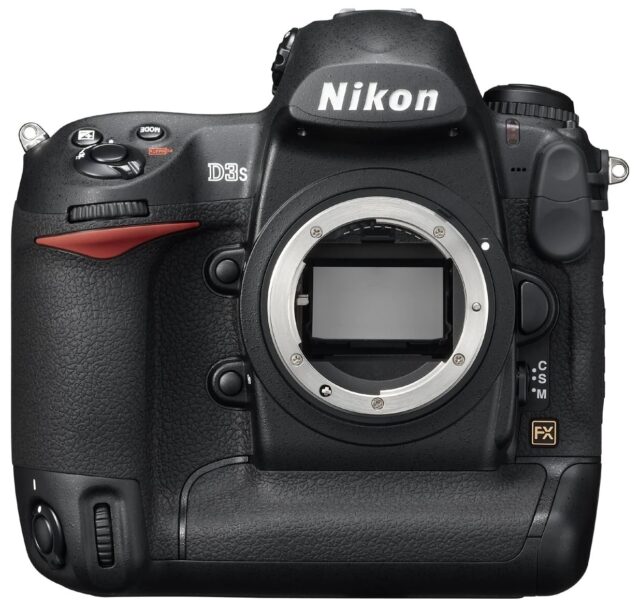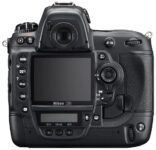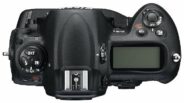Announced
Production status
System
Nikon F system cameras
- Nikkorex F
- Nikkormat EL
- Nikkormat ELW
- Nikkormat FS
- Nikkormat FT
- Nikkormat FT2
- Nikkormat FT3
- Nikkormat FTN
- Nikon D3
- Nikon D3s
- Nikon D3X
- Nikon D4
- Nikon D4s
- Nikon D5
- Nikon D6
- Nikon D600
- Nikon D610
- Nikon D700
- Nikon D750
- Nikon D780
- Nikon D800
- Nikon D800E
- Nikon D810
- Nikon D850
- Nikon Df
- Nikon EL2
- Nikon EM
- Nikon F
- Nikon F100
- Nikon F2
- Nikon F3
- Nikon F4
- Nikon F5
- Nikon F6
- Nikon FA
- Nikon FE
- Nikon FE10
- Nikon FE2
- Nikon FG
- Nikon FG-20
- Nikon FM
- Nikon FM10
- Nikon FM2
- Nikon FM2/T
- Nikon FM3A
- Nikon N2000
- Nikon N2020
- Nikon N4004
- Nikon N4004S
- Nikon N50
- Nikon N5005
- Nikon N55
- Nikon N60
- Nikon N6000
- Nikon N6006
- Nikon N65
- Nikon N70
- Nikon N75
- Nikon N80
- Nikon N8008
- Nikon N8008S
- Nikon N90
- Nikon N90S
Nikon D3s
35mm AF digital SLR camera • Discontinued
Specification
| Format: | |
| 35mm full frame | |
Imaging sensor: | 36 × 23.9mm CMOS sensor |
Resolution: | 4256 × 2832 - 12 MP |
Sensor-shift image stabilization: | - |
| Nikon F [46.5mm] | |
| Shutter: | |
Type: | Focal-plane |
Model: | Electronically controlled |
Speeds: | 30 - 1/8000 + B |
| Exposure: | |
Exposure metering: | Through-the-lens (TTL), open-aperture |
Exposure modes: | Programmed Auto |
| Aperture-priority Auto | |
| Shutter-priority Auto | |
| Manual | |
| Physical characteristics: | |
Weight: | 1240g |
Dimensions: | 159.5x157x87.5mm |
Manufacturer description
TOKYO – Nikon Corporation is pleased to announce the introduction of its newest FX-format digital SLR flagship for fast response and high light sensitivity: the Nikon D3S.
Standing on the shoulders of the world-renowned D3, the D3S takes the potential of Nikon's proprietary FX format to incredible new levels designed to meet or exceed a professional's high standards. The D3S delivers ISO 200 to ISO 12800 as standard, with the excellent noise control and wide dynamic range that the D3 is famous for. This provides photographers of any discipline with additional latitude to achieve quality images in most lighting situations. When needed, ISO sensitivity can be expanded from Lo 1 (ISO 100 equivalent) up to Hi 3 (ISO 102400 equivalent), making a significant difference in extremely low-lit shooting scenarios and other situations where faster shutter speeds or more depth of field is required.
In a first for an FX-format flagship, the D3S incorporates the HD-quality D-Movie function, letting users take full advantage of the wide dynamic range and high ISO performance, including the breakthrough High-Sensitivity Movie mode. The D3S's D-Movie also offers compatibility with an external stereo recording microphone, as well as convenient in-camera editing functions such as the ability to select the starting or ending points in order to trim D-Movie footage, as well as the option to save selected movie frames as JPEGs. The D3S shoots approximately 9-frames-per-second high-speed continuous shooting in FX format and 11 fps in DX format, with a buffer twice the size of the D3's. These features, along with a 0.04-second* shutter release time lag and improved AF accuracy work seamlessly for lightning-fast responses. Various improvements in ergonomics, operation, and reliability, such as image sensor cleaning, will help photographers focus on shooting under any conditions. When combined with state-of-the-art NIKKOR lenses and the Nikon Total Imaging System, which includes Nikon Speedlights, wireless transmitters and various software, the D3S delivers exceptional quality and versatility for an unprecedented variety of professional and personal assignments.
Nikon D3S Feature Highlights
ISO performance: ISO 12800 as standard, expandable to ISO equivalent of 102400 (Hi 3)
Professional photographers can now rely on ISO 200 to ISO 12800 as the professional standard of image quality for their assignments — an incredible advantage when shooting indoor sports, stadium events at night, dimly lit spot news or any other shooting situation where light is limited and Speedlights are not applicable. Shooting at ISOs as high as 12800, the D3S can take commercial-quality, tack-sharp images in low light at action-freezing shutter speeds — a capability that will open a new world of photographic opportunities. When needed, the D3S expands to the amazing ISO equivalent of 102400, still revealing colors and details even in extremely low-lit places where human eyes may find it difficult to discern objects. This exceptional low-noise performance also applies to D-Movie capture, which creates new potential for multimedia projects and assignments.
Large pixel pitch: the 12.1-megapixel FX-format advantage
The D3S's image sensor has been completely redesigned from the one utilized in the D3. This new sensor's inner structure has been further optimized, with the pixel count and large pixel pitch maintained for even greater latitude in high ISO performance. As a result, the D3S captures and renders light in ways that no other ordinary digital SLR cameras have yet achieved, with a significantly higher signal-to-noise ratio and a wide dynamic range for unmatched image quality for both still images and movies throughout the broadened ISO sensitivity capabilities.
New and improved D-Movie function
From well-lit scenes to extremely low-lit situations, the D3S's D-Movie mode delivers unique versatility. The newly refined D-Movie offers HD quality (1,280 x 720 pixels) Motion-JPEG movies at 24 fps. By controlling the aperture from the widest f-stop to the smallest, the large FX-format sensor renders low-noise images with beautiful bokeh effects from a large selection of NIKKOR lenses. High-Sensitivity Movie mode allows users to shoot at up to ISO equivalent of 102400 in places too dark to see clearly with their own eyes. D-Movie footage is easy to trim in-camera by simply selecting the starting or ending point. An extra bonus for sports and spot news photographers is the ability to save selected movie frames as JPEGs for immediate print and web publishing needs. The D3S has both an internal monaural microphone and an external stereo microphone input, enabling higher fidelity audio recording.
Image sensor cleaning: assured protection
Another important improvement from the D3 is the employment of the Image Sensor Cleaning function, which generates vibrations at four specific frequencies to optimize dust removal. This function can be set to operate automatically when the camera is turned on and off, or manually.
EXPEED: Nikon's comprehensive approach to quality digital images
Nikon's fast, comprehensive, and energy-efficient approach to in-camera image processing maintains the rich initial data's integrity through 14-bit A/D conversion and a 16-bit image-processing pipeline, which shows the enormous creative potential inherent in the NEF (Nikon Electronic Image Format). Combined with Nikon's FX-format sensor, the D3S produces an exceptional tonal range and minimized tone jumps. Users can expect more accuracy with difficult color combinations such as skin tones and strong reds in the same frame without over-saturation, plus finer tonal gradation in highlights, even with extremely bright subject matter.
Lateral chromatic aberration reduction: edge-to-edge sharpness
The D3S corrects color fringes caused by chromatic aberrations that, in some instances, can appear at the edges between differing subject elements. Because lateral chromatic aberrations are corrected regardless of lens type — whether telephoto, wide-angle, non-CPU and other types of NIKKOR lenses — this important aspect of the D3S contributes substantially to the highly refined, edge-to-edge image integrity that professionals demand.
Active D-Lighting: rescuing tone in highlights and shadows
Nikon's Active D-Lighting automatically regulates the dynamic range of high-contrast scenes, pulling out shadow details and preserving highlights while maintaining proper contrast. The D3S allows photographers to choose from six Active D-Lighting settings, including the newly added Auto and Extra high, as well as High, Normal, Low and Off. You can also bracket Active D-Lighting strength levels up to five frames and select the best rendition afterwards.
Picture Control: custom-tailored tone and color
Picture Control helps you define the look and feel of your images by custom-tailoring sharpness, saturation and other parameters to match your creative intentions. The D3S comes with four pre-installed Picture Control profiles, which can be fine-tuned and saved as new custom Picture Control profiles that match your personal shooting style or particular shooting conditions. These profiles can easily be copied to additional cameras.
Speed and readiness throughout the workflow
The D3S optimizes workflow speed and fluidity throughout the entire shooting process. Start-up time is approx. 0.12 seconds* and release time lag is minimized to approx. 0.04 seconds*, exactly as fast as the D3, but the D3S's increased buffer memory is twice as large as that of the D3's. In addition, the D3S's autofocusing, image processing, memory card access and recording, USB interface and optional wireless transmitter all work together to keep professional photographers focused and moving forward. And for sport and spot news photographers, many of the D3S's JPEG files are print-ready with little or no post-production: an extra edge when time is short. * Based on CIPA Guidelines.
9-frames-per-second* shooting rate in FX format, 11 fps* in DX crop
The D3S's continuous shooting rates are impressive, but what makes them truly unique is that the D3S's powerful stepping motor allows for a steadier delivery of fast continuous shooting speeds at a wider range of aperture settings than lesser cameras can achieve. Professionals will now have greater control and fewer limitations when creating the images they desire. With the DX crop, photographers can also add a 1.5x picture angle and a faster frame rate to their arsenal. Furthermore, the factory-installed buffer memory is twice the capacity of the D3, dramatically increasing the power of continuous shooting.
Scene Recognition System: enlightened accuracy and intelligence
Nikon's exclusive 1,005-pixel RGB sensor precisely reads brightness and color information to raise the overall accuracy of AF, AE, i-TTL flash control and auto white balance to new heights, thanks to the Scene Recognition System. The D3S's AF delivers superb subject tracking and subject identification performance. Highlight analysis used for AE reproduces brightness faithful to what your eyes see, and light source identification makes auto white balance uniquely precise and reliable.
51-point AF: fast and accurate subject acquisition
The D3S's strategically positioned 51 AF points deliver faster focus, even with quick and/or erratic subject movement. The 15 cross-type sensors in the center of the frame maintain the same outstanding performance with any AF NIKKOR lens f/5.6 or faster. There are four Dynamic-area AF options, including 51 points (3D-tracking), which accurately follows your subject by shifting focus points using color and brightness information from the Scene Recognition System. This gives users an extra advantage when composition is important but your subject's movement is extremely erratic. Single-point and Auto-area AF modes are also available.
Sophisticated AE with highlight analysis
Nikon's exclusive 3D color matrix metering II is highly praised for its outstanding performance and faithful exposure results — even in complex, unforgiving lighting conditions. The D3S takes accurate exposure further, using highlight analysis from the Scene Recognition System and then carefully selecting from a database containing information from over 30,000 actual shooting situations.
Informed auto white balance
Leading professionals often note that Nikon's auto white balance exhibits remarkable results, even in challenging conditions with mixed light sources. With the D3S, auto white balance makes even further progress. Professionals can expect white as truly white in a wider variety of settings.
Approx. 100% frame coverage
The D3S's large prism gives you the FX-format visual advantage when you shoot. Not only is the viewfinder image larger and brighter, the focusing screen is also carefully designed to help you more intuitively sense sharp focus, be it manual or autofocus.
Superior durability
For the reliability professionals demand, the shutter of the D3S has been tested for up to 300,000 cycles in fully assembled cameras under rigorous conditions. The ruggedly constructed D3S employs a strong yet lightweight magnesium alloy for its body, exterior cover, chassis and mirror box. Furthermore, a comprehensive series of O-rings and other specialized seals, combined with additional Nikon engineering, protect the D3S against invasive moisture, dust and even electromagnetic interference.
Twin CF card slots
The D3S lets you designate each card slot for certain tasks: record two full CF cards of data sequentially for a large amount of storage, record the same data onto two cards (backup), record RAW and JPEG simultaneously onto separate cards, and transfer data from one card to another. You can also designate the slot for data-heavy D-Movie recording.
Long-life battery
The D3S uses an EN-EL4a rechargeable battery. Power consumption and power management systems have been engineered for greater operating efficiency, so you can expect long battery life, shooting up to 4,200 images* per charge.
Easy-to-access Live View mode
The dedicated Live View button gives you instant access to two Live View modes: Tripod mode for accurate AF operation and Hand-held mode for more versatile shooting angles. The speed for Contrast-detect AF in Tripod mode has also been improved for enhanced practicality.
Quiet Shutter-release mode for nonintrusive shooting
Photographers can select "Q" on the release mode dial to substantially reduce the sound of the camera's mirror-down during shooting. This is particularly useful when shooting in restrictive conditions such as when photographing theatrical performances or wildlife.
3-in., approx. 921k-dot color, 170° viewing angle LCD monitor
The D3S's large, high-resolution LCD monitor delivers bright, crisp image playback with up to 27x enlargement for immediate and precise image confirmation. Each LCD is covered with scratch-resistant tempered glass and individually calibrated and fine-tuned at the factory to ensure consistent performance.
Additional Nikon D3S Features
- Newly added image area of 1.2x crop (30 x 20) format with approx. 8.4 megapixels
- Multiple exposure operation that can be repeated by designating the function to the bracketing button
- Electronic virtual horizon that is available in Live View shooting
- Extended menu banks that store up to four combinations of exposure mode, shutter speed and aperture value
- Versatile in-camera Retouch Menus, including RAW processing to enhance your images without using a computer
- Compatible with HDMI (High-Definition Multimedia Interface) output. Type C connector (mini size) is employed.
- With the optional GPS Unit GP-1, location information such as latitude, longitude, altitude and time are automatically recorded to each image's EXIF data. The Time Adjustment feature, which adjusts your camera's time zone, is also available using the GP-1. Especially useful for group assignments that require several D3S cameras to be synchronized.
- Exclusive Nikon Software — Nikon Transfer and ViewNX software packages (supplied) for a range of basic photo browsing and editing operations; Capture NX 2, Camera Control Pro 2, and Image Authentication Software (all optional) enable more advanced operation and image editing.
Similar cameras (2)
35mm full frame • Auto focus • Digital • Singe-lens reflex • Nikon F mount
| Model | Shutter | Metering | Modes | Year |
|---|---|---|---|---|
| Kodak DCS Pro 14n | E, 1/4000 | TTL • OA | PASM | 2002 ● |
| Kodak DCS Pro SLR/n | E, 1/4000 | TTL • OA | PASM | 2004 ● |


